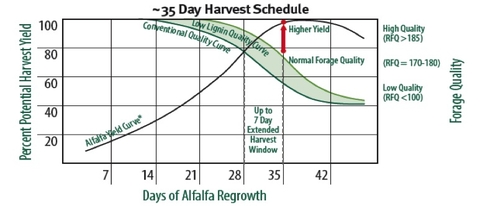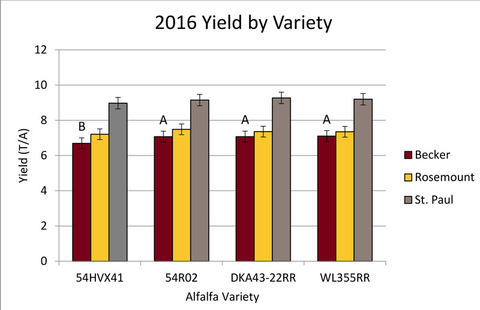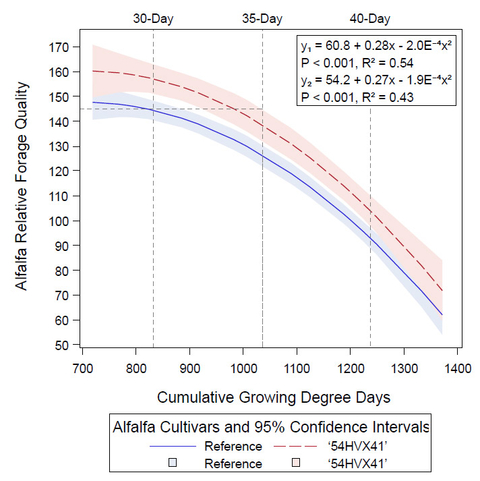Alfalfa is widely used as forage for livestock due to its high nutrient content. However, the crop’s lignin content hampers animals’ ability to digest and use alfalfa.
Fortunately, relatively new alfalfa varieties with reduced-lignin concentrations have the potential to increase the feeding value of alfalfa and widen the optimal harvest window.
Understanding reduced-lignin alfalfa varieties
Lignin is a complex structure that makes up part of the plant’s fibrous portion. While it provides the plant with the strength and rigidity necessary to stand upright, lignin is an indigestible plant component that reduces the fiber digestibility of forages.
Lignin is a phenolic polymer linked with cellulose, hemicellulose and pectin in the cell wall. It constitutes about 6 to 9 percent of the whole alfalfa plant’s dry weight and about 20 percent of the cell wall.
Cell walls represent about 40 to 50 percent of harvested forage and are composed of cellulose, hemicellulose, lignin, pectin and protein. Cell wall digestibility is variable and negatively related to lignin concentration.
Within the plant, lignin strengthens cell walls that are the structural building blocks to support the stems and leaves. Cell walls also act as tubing for the vascular system that transports water and nutrients throughout the plant. However, lignin’s close association with cellulose and hemicellulose in alfalfa cell walls limits their rumen microbe degradation.
There have long been efforts to improve alfalfa forage quality through conventional plant breeding. However, significant forage quality improvements haven’t been made until recently, when three alfalfa breeding companies announced development of varieties with reduced lignin content.
HarvXtra
HarvXtra is a transgenic, reduced-lignin alfalfa. A cooperative effort between Forage Genetics International (FGI), the Samuel Roberts Noble Foundation and the U.S. Dairy Forage Research Center developed the new alfalfa.
They produced it by deactivating enzymes in a lignin synthesis pathway. It contains about 12 to 18 percent less whole plant lignin and has improved cell wall digestibility.
Dairy cow feeding trials with this transgenic low-lignin alfalfa forage as a portion of the ration showed increased milk production of 2.6 pounds per head per day compared to forage from conventional alfalfa controls.
Hi-Gest 360
In addition, Alforex Seeds developed Hi–Gest 360, a reduced-lignin alfalfa variety developed through conventional plant breeding. Hi-Gest contains 7 to 10 percent less lignin than conventional alfalfa varieties.
In research trials, it had about 12 percent greater total tract digestibility than conventional varieties. Note total tract neutral detergent fiber digestibility is as estimated by a near infrared spectroscopy (NIR) analysis.
Advantages of reduced-lignin varieties
Using reduced-lignin alfalfa varieties has the potential to be very advantageous to growers.
Its improved forage nutritive value may lengthen the time period when alfalfa is best suited for high-producing livestock. This could widen the optimal harvest window, making it possible for alfalfa producers to delay harvest and achieve greater yields while still maintaining a high forage nutritive value.
At any given maturity stage, reduced-lignin alfalfa will have greater cell wall digestibility and greater feeding value than conventional varieties (Figure 1). As shown in Figure 1, reducing the lignin concentration of alfalfa varieties (low lignin quality curve) will result in higher forage quality at all typical harvest times.
In this example, growing an alfalfa variety with reduced lignin concentration will allow about a seven-day delay (from 28 to 35 days) in harvest. In addition, growers will achieve greater forage yields while harvesting the same forage quality as a 28-day schedule.
The extent it increases forage quality and extends the harvest window depends on the level of lignin reduction, which varies with alfalfa variety.
In addition, the new technology widens the harvest window without losing digestibility. This gives growers the flexibility to delay harvest to a later stage of maturity.
For example, harvesting three times at first flower has the potential to provide the same quality as four cuttings at bud stage while providing greater yields. In trials in Minnesota and Wisconsin, yields from an early flower harvest regime were from 15 percent to as high as 40 percent greater for delayed harvests after bud stage.
Less frequent harvests (e.g., three vs. four times) lower harvest costs and reduce the crop’s exposure to poor weather conditions. A three-time harvest system with flowering alfalfa also results in less traffic and less stress on the alfalfa stands than a four-time harvest system with alfalfa at bud. As a result, alfalfa stand persistence will likely increase.
Although the changes in lignin concentration in the new, reduced-lignin alfalfas may seem small, the new alfalfas have the potential to greatly increase alfalfa’s feeding value. This is because lignin concentration is so highly correlated with the forage’s digestibility.
However, because the new alfalfas vary in the level of lignin reduction, we can expect variable effects on forage digestibility. Each company incorporated the new, low-lignin trait into highly productive, winter-hardy and disease-resistant varieties, so yields and persistence should be similar.
Producers must evaluate this new technology in their harvest and cattle feeding systems to determine how it benefits their farming operations.
Research: Yield and quality of reduced-lignin alfalfa
To evaluate the yield and forage nutritive value of reduced-lignin alfalfa, researchers conducted a study that subjected reduced-lignin and reference alfalfa varieties to diverse cutting treatments during the first production year.
Alfalfa was planted in Becker, Rosemount and St. Paul in April 2015, and research was conducted during the 2016 growing season.
Alfalfa varieties included the reference alfalfa varieties 54R02, DKA43-22RR and WL355.RR, as well as the reduced-lignin variety 54HVX41.
Treatments included four cutting treatments with varying harvest frequencies ranging from 30 to 45 days. Researchers measured forage yield, forage nutritive value and plant maturity.
Cumulative forage yields for the first production year (2016) ranged from 6.6 to 9.8 tons per acre (Figure 2).
Yields were similar among alfalfa varieties in Rosemount and St. Paul. In Becker, yields for reduced-lignin alfalfa (54HVX41) were less compared to reference varieties.
As anticipated, yields were greater with a 40-day cutting schedule compared to a 30-day cutting schedule. Average yields were 8.3 and 7.5 tons per acre across locations, respectively.
On average, reduced-lignin alfalfa showed an 8 percent reduction in acid detergent lignin (ADL) and a 10 percent increase in neutral detergent fiber digestibility (NDFD) compared to reference alfalfa varieties. Reference alfalfa varieties had an average of 8.5 percent ADL and 30 percent NDFD (Table 1).
Forage from reduced-lignin alfalfa had similar crude protein (18 percent) and NDF (42 percent) concentrations compared to reference alfalfa varieties, which averaged 18 percent crude protein (CP) and 43 percent NDF.
As anticipated, cutting treatments with shorter harvest intervals generally resulted in higher forage nutritive values, including increased CP, decreased NDF and ADL and increased NDFD compared to those with longer intervals between harvests.
Table 1: Average forage nutritive values for reduced-lignin and reference alfalfa varieties
| Forage quality measures | Reduced-lignin varieties | Reference varieties |
|---|---|---|
| Crude protein (CP) | 18.50% | 18.00% |
| Neutral detergent fiber (NDF) | 42.00% | 42.90% |
| Acid detergent lignin (ADL) | 7.90% | 8.50% |
| Neutral detergent fiber digestibility (NDFD) | 33.50% | 29.70% |
Forage quality over time
When relative forage quality (RFQ) was averaged over locations and expressed as a function of growing degree days (GDD), RFQ for reduced-lignin alfalfa was greater (from 772 to 1,248 GDD). This represents a range of cutting intervals between 28 and 40 days (Figure 3).
Increased RFQ in reduced-lignin alfalfa across a wide range of GDD and cutting intervals demonstrates this new trait’s potential to increase flexibility for alfalfa growers.
Strategies for growers
Growers could choose to harvest reduced-lignin alfalfa at the same time as reference varieties to get more digestible forage. Alternatively, they could harvest reduced-lignin alfalfa under a delayed cutting schedule and maintain forage quality across a lengthened harvest window.
For example, reduced-lignin alfalfa harvested on a 35-day cutting interval showed a 21 percent increase in yield and only a 3 percent reduction in RFQ compared to reference varieties harvested on a 30-day harvest interval (Figure 3).
This could allow for a wider optimal harvest window, enabling alfalfa growers to achieve greater yields by delaying alfalfa harvest while still maintaining high forage nutritive values.
Ball, D., Collins, M., Lacefield, G, Martin, N., Mertens, D., Olson, K., Putnam, D., Undersander, D. & Wolf, M. (2001). Understanding forage quality. American Farm Bureau Federation, 1.01.
Holin, F. (2014). Low-lignin alfalfas move toward the market. Hay & Forage Grower.
Hatfield, R.D., Jung, H.J., Broderick, G. & Jenkins, T. (2007). Nutritional Chemistry of Forages. Forages, the Science of Grassland Agriculture. R.F. Barnes et al. (Ed.). Ames, IA: Blackwell Publishing.
Mertens, D. & McCaslin, M. (2008). Evaluation of alfalfa hays with down-regulated lignin biosynthesis. Journal of Dairy Science, 91, 1.
Undersander, D., McCaslin, M., Sheaffer, C., Whalen, D., Miller, D., Putman, D. & Orloff, S. (2009). Low lignin alfalfa: Redefining the yield/quality tradeoff. Proceedings from the 2009 Western Alfalfa and Forage Conference. Reno, NV.
Undersander, D., Cosgrove, D., Cullen, E., Grau, C., Rice, M., Renz, M., Sheaffer, C, Shewmaker, G. & Sulc., M. (2011). Alfalfa management guide. American Society of Agronomy, the Crop Science Society of America, and the Canadian Society of Agronomy. Madison, WI.
Reviewed in 2023




